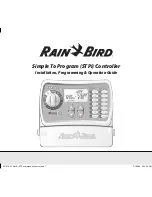
S90-010 CS (APR 08) FRICK
®
QUANTUM™ COMPRESSOR CONTROL PANEL
Page 34 COMMUNICATIONS SETUP
Since we are only looking for this one address, and no
other, we can say that we are only looking for one Data
Address. Our Data Address part of the data packet is also
looking for a High and a Low Order value. Fortunately, the
number one (1) is the same in decimal as it is in Hex,
therefore, the Low Order Address is 01 (hex). The High
Order Address is 00 (hex), so our decimal 1 is formatted
as 0001 (hex).
In order to ensure that the Quantum™ in question
receives the data request accurately, we must append an
Error Check byte to the end of the message. This is
accomplished by adding each of the byte pairs (hex) that
we have generated thus far:
01 + 03 + 00 + 87 + 00 + 01 = 8C hex
Next, subtract 8C (hex) from 100 (hex):
100 (hex) - 8C (hex) = 74 (hex)
After the entire data packet has been created, simply
press the
[Enter]
key, a Line Feed will automatically be
sent also.
Write Example:
To demonstrate how an address within the Quantum™
may be written to, the following test can be performed
using Windows HyperTerminal:
As an example, a Modbus command will be created, and
sent to set the Quantum™ to set the
Suction Pressure
Control Point 1
to 100.0 PSIA. First, be aware that data
sent to and received by the Quantum™ has one decimal
place assumed. This means that to send the value of
100.0, you actually need to send 1000. Using the address
tables found later in this manual, locate the address for the
Suction Pressure Control Point 1
. In this case, it would be
Frick
®
Address 277 (decimal). Since this is the only
address we are interested in writing to, send the following
message:
Look at this message on a more basic level, to understand
how the address that we are writing to is arrived at. We
want to send the value of 1000 (100.0) to the
Suction
Pressure Control Point 1
, Frick
®
Address 277 (decimal).
The first part of the message will be a Colon (:). This
represents a heads up alert that data is coming down the
line.
Any time that a message is sent, all of the Quantum™
panels that are on the Modbus network will become active,
communications wise, once the Colon appears. Next, all
panels will look at the first byte following the Colon (:). If
this byte equals the Panel ID # of the particular
Quantum™ being queried, it will immediately finish
reading the remainder of the message. If the byte does not
equal its ID #, the message will be ignored.
}
: 01 03 00 87 00 01 74 CRLF
Where:
Start of Message
Quantum™ ID #
Read Function
H.O. address (hex)
L.O. address (hex)
H.O. # of Data Registers
L.O. # of Data Registers
Error Correction Code
Carriage Return – Line Feed
: 01 06 01 15 03 E8 F8 CRLF
Where:
Start of Message
Quantum™ ID #
Write Function
H.O. address (hex)
L.O. address (hex)
H.O. # of Data Value
L.O. # of Data Value
Error Correction Code
Carriage Return – Line Feed
}
: 01 06 01 15 03 E8 F8 CRLF
Where:
Start of Message
Quantum™ ID #
Write Function
H.O. address (hex)
L.O. address (hex)
H.O. # of Data Value
L.O. # of Data Value
Error Correction Code
Carriage Return – Line Feed
}
: 01 03 00 87 00 01 74 CRLF
Where:
Start of Message
Quantum™ ID #
Read Function
H.O. address (hex)
L.O. address (hex)
H.O. # of Data Registers
L.O. # of Data Registers
Error Correction Code
Carriage Return – Line Feed
}
: 01 03 00 87 00 01 74 CRLF
Where:
Start of Message
Quantum™ ID #
Read Function
H.O. address (hex)
L.O. address (hex)
H.O. # of Data Registers
L.O. # of Data Registers
Error Correction Code
Carriage Return – Line Feed
















































